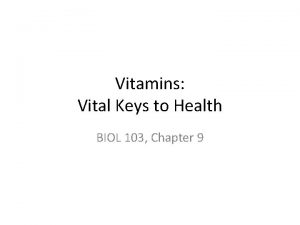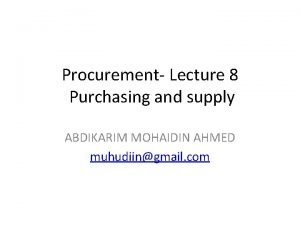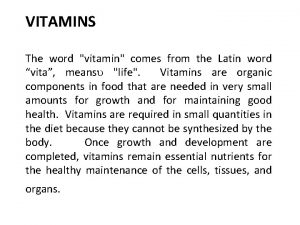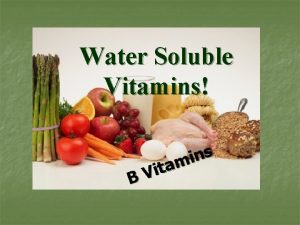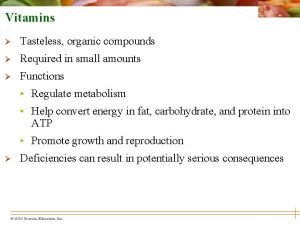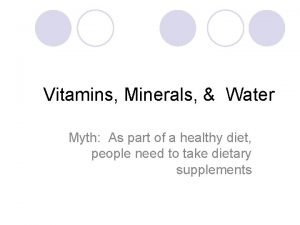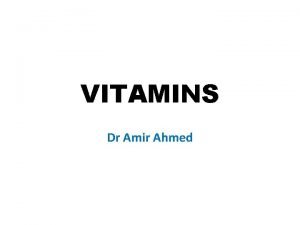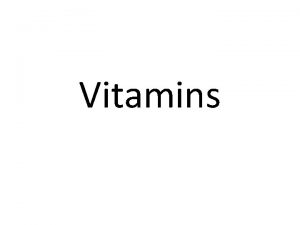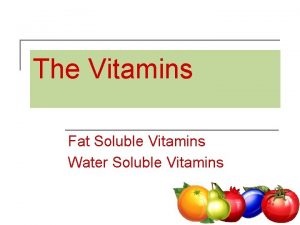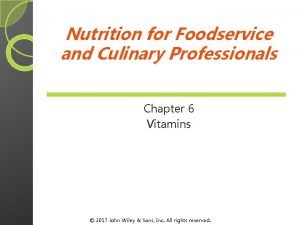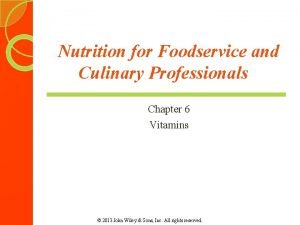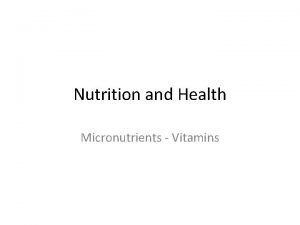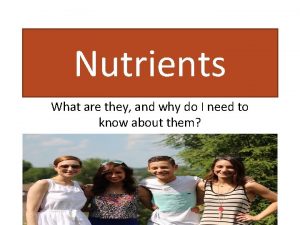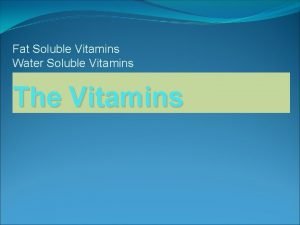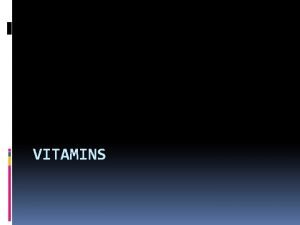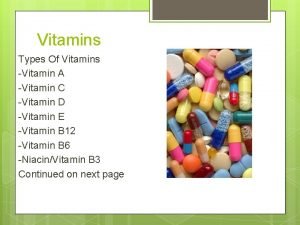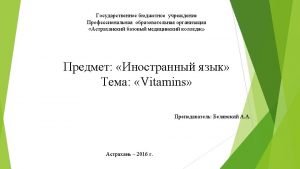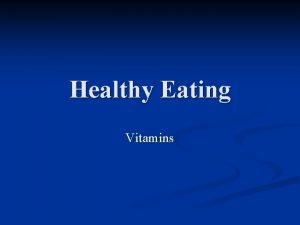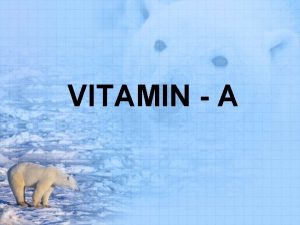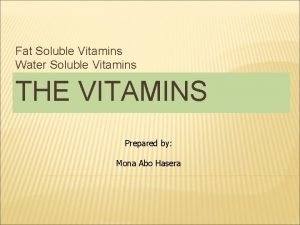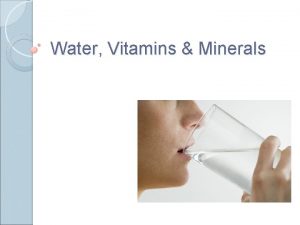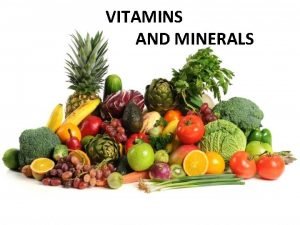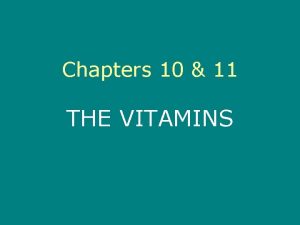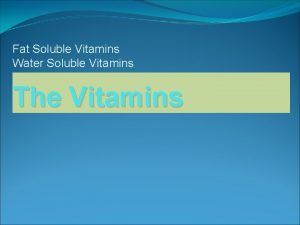VITAMINS Dr Amir Ahmed Introduction The word vitamin
















- Slides: 16

VITAMINS Dr Amir Ahmed

Introduction Ø The word "vitamin" comes from the Latin word vita, means "life". Ø Vitamins are chemicals found in very small amounts in many different foods. Ø “vitamins have been defined as organic compounds which are required in minute amounts to maintain normal health of organisms’. Ø Functions • Regulate metabolism • Help convert energy in fat, carbohydrate, and protein into ATP • Promote growth and reproduction Ø Deficiencies can result in potentially serious consequences

Classification of Vitamins FAT SOLUBLE ØA ØD ØE ØK WATER SOLUBLE Ø B 1 Thiamine Ø Ø Ø Ø B 2 Riboflavin B 3 – Niacin B 5 – pantothenic acid B 6 –Pyridoxine B 8 – biotin B 9 Folic acid B 12 Cyano. Cobalamin C vitamin (ascorbic acid) 3


Vitamin Absorption and Storage • All absorption takes place in the small intestine • Fat-soluble vitamins – Are absorbed in the duodenum – Storage • • Vitamin A is mainly stored in the liver Vitamins K and E are partially stored in the liver Vitamin D is mainly stored in the fat and muscle tissue Can build up in body to point of toxicity

Vitamin Absorption and Storage • Water-soluble vitamins – Absorbed with water and enter directly into the blood stream – Most absorbed in the duodenum and jejunum – Most are not stored in the body – Excess intake excreted through the urine – Important to consume adequate amounts daily – Dietary excesses can be harmful

The Fat-Soluble Vitamins

Vitamin A • Chemical Name • Retinol, Retinal, and Carotenoids including Beta carotene • Solubility in Fat • Function • Vision, Bone growth, Reproduction, Cell functions and in Immune system

Cont. . • Deficiency Disease • Night blindness, hyperkeratosis, and keratomalacia. Conjunctival xerosis, bitot’s spot, Corneal xerosis • Toxicity • Hypervitaminosis A • Food Source • Liver, orange, ripe yellow fruits, leafy vegetables, carrots, pumpkin, squash, spinach, fish, soy milk, milk

Picture of Conjunctival xerosis, bitot’s spot, hyperkeratosis, Corneal xerosis, keratomalacia

Vitamin D Chemical Name Cholecalciferol (D 3), Ergocalciferol (D 2) Solubility in Fat Function Needed for proper absorption of calcium; stored in bones • Deficiency Disease Rickets and osteomalacia • Toxicity Hypervitaminosis D • Food Source Lichen, eggs, liver, certain fish species such as sardines, certain mushroom • • •

Rickets and osteomalacia

Vitamin E • Chemical Name • Tocopherols, Tocotrienols • Solubility in Fat • Function Antioxidant; protects cell walls • Deficiency Disease Deficiency is very rare; mild hemolytic anemia in newborn infants • Toxicity Possible increased incidence of congestive heart failure • Food Source Many fruits and vegetables, nuts and seeds, and seed oils


Vitamin K • Chemical Name • Phylloquinone (k 1), Menaquinones(k 2) • Solubility in Fat • Function Needed for proper blood clotting • Deficiency Disease • Deficiency: increased bleeding and hemorrhage rare, they may occur in some individuals when antibiotic medications kill the intestinal bacteria that produce the vitamin. • Toxicity Decreased anticoagulation effect of warfarin • Food Source Leafy green vegetables such as spinach; egg yolks; liver

To be continued. .
 Water soluble vitamins vs fat soluble vitamins
Water soluble vitamins vs fat soluble vitamins Ahmed muhudiin ahmed
Ahmed muhudiin ahmed The word vitamin comes from
The word vitamin comes from Water soluble vitamins characteristics
Water soluble vitamins characteristics Where vitamins are absorbed
Where vitamins are absorbed Function of minerals
Function of minerals Vitamin d ergocalciferol
Vitamin d ergocalciferol Vitamin classification chart
Vitamin classification chart Vital amines examples
Vital amines examples Water soluble vitamins characteristics
Water soluble vitamins characteristics The chef does everything but cook that's what wives are for
The chef does everything but cook that's what wives are for Categories of vitamins
Categories of vitamins Orange vegetables list
Orange vegetables list Different forms of vitamin a
Different forms of vitamin a Benefits of dark leafy greens
Benefits of dark leafy greens Vitamins and their functions sources and deficiency chart
Vitamins and their functions sources and deficiency chart Scorbutic rosary
Scorbutic rosary
